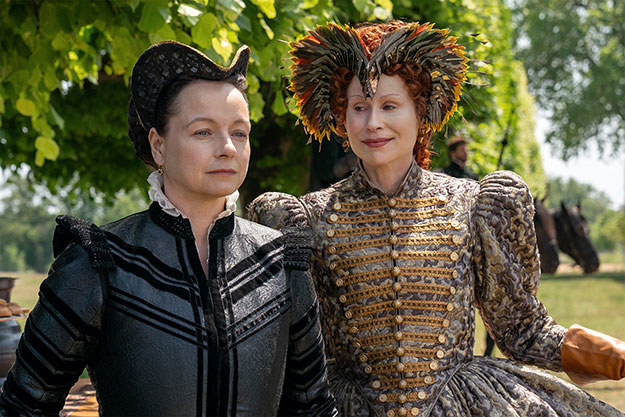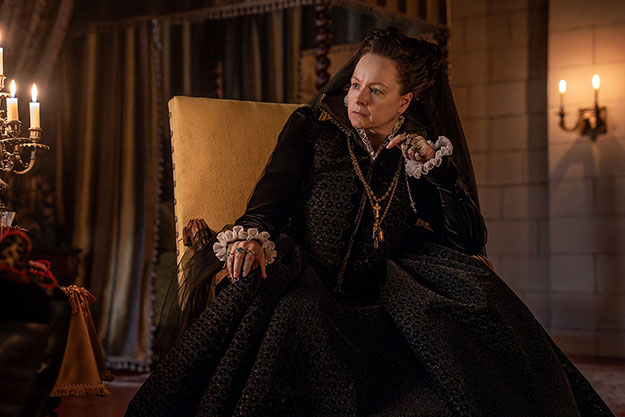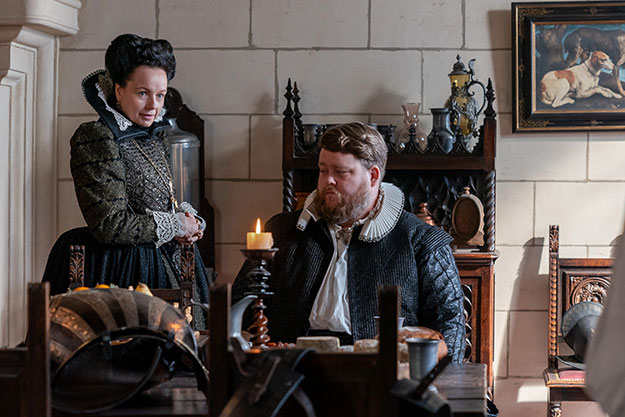“The Serpent Queen” (S2): Power, Intrigue, and the Complexities of Female Leadership

As a woman with a keen interest in social issues and philosophical ideas, the allure of STARZ’s “The Serpent Queen” is undeniable. This historical drama, set in the 16th century, brings to life the riveting and often misunderstood story of Catherine de Medici. With Season Two premiering tomorrow night, the excitement is palpable. During the TCA Press Tour, the cast and creators provided a compelling preview of what viewers can expect from this delightfully wicked series.
“The Serpent Queen” reimagines the life of Catherine de Medici, a woman historically portrayed as a manipulative and ruthless ruler. However, in this series, we see her as a multifaceted character with intelligence, resilience, and a will to survive. Samantha Morton, who plays Catherine, shared her insights on portraying such a complex character: “It’s about resilience and survival. And I’m not sure how you were kind of raised in the way of Catherine de Medici, but I think for me it’s kind of my understanding is a lot of history has been written by men.”
Morton’s portrayal brings depth and nuance to Catherine, challenging the traditional narratives that have often painted her in a negative light. Her performance is informed by the script, which she describes as her Bible, and her own instincts and experiences. This approach allows her to connect with Catherine on a personal level, making her portrayal both relatable and profound.
Season Two of “The Serpent Queen” introduces Minnie Driver as Queen Elizabeth I, Catherine’s formidable rival. The dynamic between these two powerful women is central to the new season. Driver described her character as a “witty, wily, slightly feral queen,” a depiction that deviates from the often rigid portrayals of Elizabeth I.

Driver emphasized the unique relationship between Catherine and Elizabeth: “These are two business people who meet and there is no one else like them in the world at that time. They are recognizing each other as these two women who are the regents of their respective countries.” This recognition and mutual respect form the basis of their interactions, adding a layer of complexity to their rivalry.
One of the distinctive elements of “The Serpent Queen” is its use of breaking the fourth wall, where Catherine addresses the audience directly. Morton explained her inspiration for this technique, citing Martin Scorsese’s “Goodfellas” as a reference. “I’m performing exactly the same, but then all of a sudden it’s like, oh I have -- you know I digress and then I say what I’m really feeling in here. Like how would you do it, what would you do?”
This approach not only makes the series more engaging but also allows viewers to connect with Catherine on a deeper level. It’s as if she is confiding in the audience, sharing her innermost thoughts and struggles. This technique enhances the storytelling, making it more intimate and immersive.
The music in “The Serpent Queen” plays a crucial role in setting the tone and atmosphere of the series. Creator Justin Haythe explained that he often has specific songs in mind when writing and uses them on set to enhance the scenes. The choice of contemporary music, particularly punk rock, underscores the rebellious and survivalist spirit of the characters.

Haythe elaborated on this choice: “I never wanted to introduce a contemporary song anywhere in an episode. It only happens at the end because the show is irreverent and funny, but it’s also the stakes are very real for these people.” This blend of historical setting with modern musical influences adds a unique flavor to the series, making it both timeless and contemporary.
Balancing historical accuracy with creative storytelling is a delicate task, but “The Serpent Queen” manages to do so effectively. Haythe emphasized the importance of grounding the series in real events while also allowing for creative interpretation where historical records are ambiguous. “We had a principle where if you could prove it happened, we were obliged to it... At the same time, if you can’t prove it didn’t happen, we can do it.”
This approach allows the series to stay true to the spirit of the times while also exploring the characters’ motivations and actions in a way that resonates with modern audiences. The result is a rich, layered narrative that feels both authentic and innovative.
Season Two promises to delve deeper into the characters’ psyches, exploring their motivations and the consequences of their actions. Haythe mentioned that this season will focus on the cost of survival for Catherine, particularly how her decisions affect her children. “What is she going to do once she has the throne which is season two, and then the question is what’s the price of survival.”

Morton’s portrayal of Catherine captures this internal struggle, making her a compelling anti-heroine. Despite her ruthless actions, the audience is invited to empathize with her, understanding the harsh realities she faces in a male-dominated world.
“The Serpent Queen” stands out in the genre of historical drama by infusing it with modern sensibilities and a touch of irreverence. It’s a series that doesn’t shy away from portraying the brutality and intrigue of the times while also celebrating the strength and resilience of its female protagonists.
For viewers who appreciate complex characters and thought-provoking narratives, “The Serpent Queen” offers a rich tapestry of intrigue, power struggles, and personal drama. I find this series to be a fascinating exploration of history through a contemporary lens. It’s a reminder that the past is not just a collection of dates and events but a story of people, their ambitions, and their survival.
With its stellar cast, captivating storytelling, and innovative approach, “The Serpent Queen” is set to be a highlight of the television season. Whether you’re a history buff or a fan of compelling dramas, this series is sure to leave a lasting impression.












